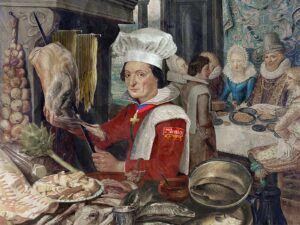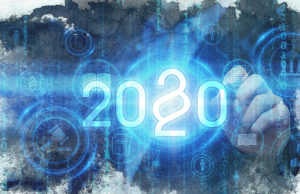
Born in 1218: Rudolf of Habsburg
Rudolf of Habsburg is one of the most successful figures this country has ever produced. The later king of the Holy Roman Empire laid the groundwork for Habsburg Austria.
The year 2018 is in many ways a year of celebration and commemoration for Switzerland. The year 1218 has special meaning for present-day Switzerland’s history. The demise of the Dukes of Zähringen, the most important family in the southwestern part of the Holy Roman Empire, led to a reshuffling of power in 1218. The main beneficiaries south of the Rhine were the Counts of Kyburg, followed by the Counts of Habsburg, who had proved themselves to be loyal vassals of the Staufer kings. And 1218 is also considered to be the birth year of Rudolf of Habsburg, the rising star of the 13th century and progenitor of the subsequent Habsburg Empire.
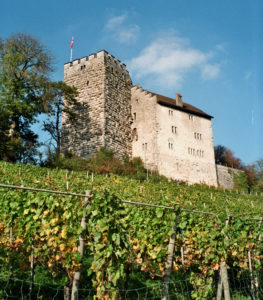
The Habsburg family castle above the municipality of the same name in Aargau. Photo: Bruno Meier
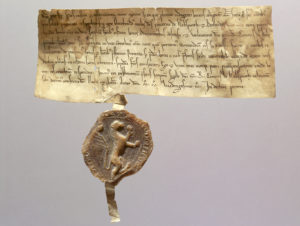
Document from 1243 with the seal of Count Rudolf of Habsburg. Photo: Swiss National Museum
There is a legend that Staufer King Frederick II was Rudolf’s godfather. Whether or not this is true, the Habsburgs always regarded themselves as loyal to the Staufers and saw themselves as the Staufers’ successors, though they were not related to them. Many legends surrounding Rudolf of Habsburg arose soon after his death in family chronicles and can be described as ruling propaganda. They depict the Habsburger as successful and hard-working, but also as a popular and wise ruler.
Rudolf was the son of Albert IV, who was married to Hedwig of Kyburg and probably died on a crusade in 1239/40. This alliance was also later the basis for the Habsburgs’ claim to succession after the death of the Kyburgs. In 1240 Rudolf and his cousins from the branch of the family later known as the Laufenburg line took up the position of head of the family. He rose to prominence as a retainer of the Staufer King in the northern Italian wars and even kept his allegiance to Frederick II during a heavy dispute with the Pope in the ensuing years, unlike his cousins. Only after the death of the King in 1250 and his son Conrad IV in 1254 was Rudolf forced to adapt to this new situation. That same year he married Gertrude of the Swabian noble family of Hohenberg. During the following years, Rudolf of Habsburg was among the most successful noblemen who managed to massively expand their power during the so-called Interregnum, the period without a recognised king. This included his position in Alsace, which was strengthened by his marriage and where he took a timely stand with the city of Strasbourg in a conflict against the bishop of Strasbourg. This also included a massive expansion of power in the Black Forest that finally culminated in his claiming succession after the death of the Kyburgs from 1264, despite the resistance of the Counts of Savoy. He claimed succession partly for himself, partly for his cousin Eberhard of the Laufenburg line in order to maintain his own influence. Rudolf of Habsburg thus became a central figure in the region between Lake Geneva and Lake Constance.
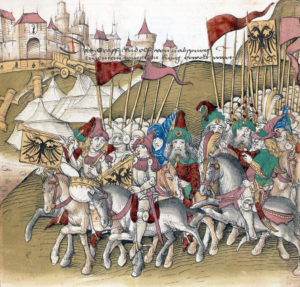
Just outside of Basel, Rudolf of Habsburg learns that he has been elected king. Spiezer Schilling ca. 1483, Burgerbibliothek of Berne. Image: e-codices
In 1273 he was unexpectedly elected king. The reasons for this are unknown; it is believed that the electing princes did not want one of their own with great power, but rather one who was less powerful and who nevertheless had the potential to restore the structures of the Empire that had been neglected during the Interregnum. And Rudolf achieved this in an astonishingly short period of time and with great success. Not only did he put his family on par with the great imperial princes through numerous marriages, he also prevailed in the conflict with the King of Bohemia over the duchies of Austria and Styria in 1278. Four years later, he achieved crowning success with the bestowal of the two duchies on his sons Albert and Rudolf, thereby laying the groundwork for Habsburg Austria.
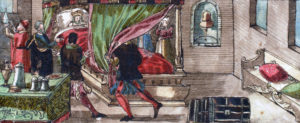
Rudolf of Habsburg on his deathbed. Silbereisen: Chronicon Helvetiae, Part 1, ca. 1576, Cantonal Library of Aargau. Image: e-codices
Rudolf died on 15 July 1291 in Speyer. He intentionally went to an important burial ground of Salian and Staufer kings to die, thus underlining the Habsburgs’ claim to succession. Rudolf has maintained a surprisingly positive image in Swiss national history, although he consistently forged ahead with expanding his power on what is now the Swiss plateau and, just before his death, made an important acquisition in central Switzerland with the purchase of Lucerne. It is unclear whether the three regions of Uri, Schwyz and Unterwalden actually formed an alliance as a result of his death, since the Federal Charter from early August 1291 is still disputed to this day. In any case, however, it was mainly his grandchildren and great-grandchildren in the 14th century who had to grapple with the expanding Confederation, in most cases with a poor outcome for themselves.
And still: Rudolf of Habsburg, if we can claim him as part of Swiss history, is one of the most successful figures this country has every produced.
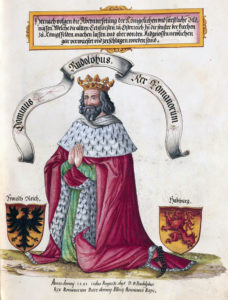
Rudolf of Habsburg in a drawing based on the unpreserved donated window series in Königsfelden. “Fugger’scher Ehrenspiegel des Hauses Österreich” (Austrian almanac of honours) from 1555, Bayrische Staatsbibliothek. Image: digitale-sammlungen.de


